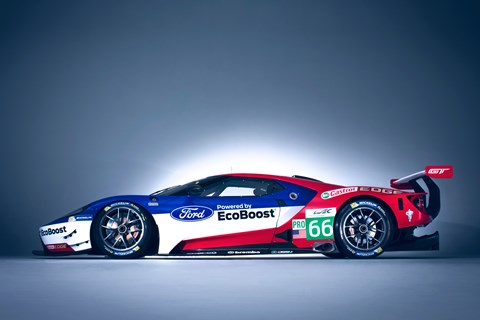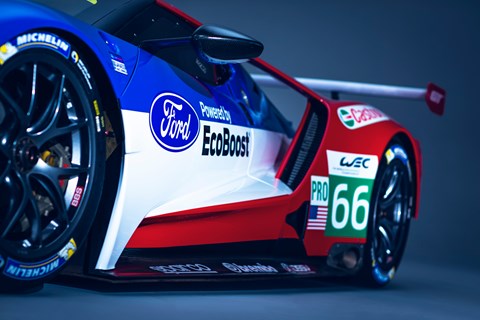► ‘The race car is the road car, and vice versa’
► How the quest to win Le Mans has shaped the new Ford GT
► CAR interviews the man responsible for building it
If you’ve seen the December 2015 issue of CAR magazine you’ll already have read how the head of Ford Performance and the man with overall responsibility for the new Ford GT, Dave Pericak, reckons ‘the road car is the race car and the race car is the road car’ (CAR+ subscribers can click here for a recap). But what does that really mean for Ford’s new supercar in practical terms?
To find out we caught up with the man in charge of actually building both the road and race versions – vice president of Multimatic Engineering, Larry Holt – during the press conference announcing the racing Ford GT’s World Endurance Championship driver line-up.
Hold on a minute – who are Multimatic Engineering, and what have they got to do with the new Ford GT?
Being an enormous global car manufacturer doesn’t necessarily mean you have the facility to turn out a low-volume carbonfibre wondercraft, so Ford went to Canadian automotive engineering firm Multimatic for help.
We say ‘Canadian’ – Multimatic has operations spanning the globe, and its expertise ranges from building fold-out tailgate steps for Ford pick-up trucks to winning races. Specialisms include lightweight technology (read: carbonfibre) and active aerodynamics.
As a result, Multimatic Engineering has been tasked with developing and building the new GT since the start. And although Pericak also insists the GT was always a road car first, the extent to which the race programme has shaped the new supercar is exceptional.

So what are the advantages of building the race car and the road car at the same time?
According to Holt, ‘It’s about taking advantage of things you’re not allowed to do by the racing rules.’ He doesn’t mean cheating so much as simply building the road car to the best advantage of racing. For although there are areas known as ‘freedom boxes’ in the WEC rules where the race engineers and aero people can go wild, much of the race car’s shape is dictated by the road car.
‘There are some things that you are not allowed to do,’ Holt explains. ‘You’re not allowed to have big openings behind the front wheels for instance. And there are big openings on this car. But if you look at the road car it has big openings. It has the buttresses, it has the charge air coolers outboard, in the free stream, it’s got a very small frontal area, it’s waisted in at the back, and it’s waisted in at the right angle to get aerodynamic attachment.’
And this was made possible because the road and race car were being developed as the same time?
Essentially, yes. But there’s more to it than that. ‘It’s not just about doing them in parallel, because you can do it in parallel and not have cooperation,’ explains Holt. ‘We did it in parallel with unbelievable cooperation with the Ford engineering and design people. Any time we said we need to bulge this a bit, we need to this or we need to do that, there was no push back – I mean these guys embraced it and completely understood what we were doing.’
This cooperation was driven by what Holt describes as ‘passion – right from the top of the company.’ Ford president and CEO Mark Fields was on-board from the start, while the global vice president for engineering, Raj Nair, ‘personally’ made the technical decision whenever there was a conflict. Holt says it’s this passion that also explains the huge resources Ford is pumping into the GT racing project.

Does this explain how Ford has managed to bring the GT to life so quickly?
‘That whole story about a bunch of guys in the basement, at Ford? That’s all true.’ Holt says with a grin. ‘That’s a completely true story. And they worked night and day. I had three guys with them, so there were those nine Ford guys and three Multimatic guys, and then my aero team lead by Mark Handford.
‘And we ran more aero CFD [Computational Fluid Dynamics] than I have on any programme, ever. We were churning it – and because of the time difference between the UK and Canada and my Australian shop we were able to just churn it round the clock. That’s how we got so much done in such a short time.’
What does all this mean for the Ford GT road car?
Well, for one thing, the interior is going to be a tight fit: ‘When you’re laying out a car and you set up the cabin, there’s a bunch of things that a lot of people have an opinion on and it ends up being a certain way,’ says Holt. ‘I can tell you this isn’t the optimal way for a race car.’ Since the Ford GT is basically a race car, the road car buyers are going to find it a little… cosy.
‘It’s sort of bookends in the market. When you’re building a sedan, you go: I want the biggest and best in class. In this case, it’s what is the smallest we can get away with?’ So Ford and Multimatic looked for the most compact driver and passenger arrangement currently on sale in a sports car. ‘It’s a Lotus Elise. Well, if they get away with it, then we can get away with it!’

So there are ‘some compromises’ in service of the race car. ‘But what you get from that – you get unbelievable performance, just an incredible amount of performance in the car. Which you maybe don’t get when people are making decisions for other reasons.’
Besides, Holt is keen to point out they also didn’t have total freedom – ‘you gotta crash the thing’ for starters. And the new Ford GT road car meets all the different global regulations for this.
Does Larry Holt think the Ford GT is a winning car?
Well, he’s certainly a little concerned about the ‘balance of performance’ adjustments meted out by the FIA after they viewed the car in December (adding ‘I don’t blame ‘em for looking at it and going we should slow these guys down and not let them come out of the box so hard!’).
But if the GT doesn’t win on its debut at the Daytona 24 Hours at the end of January, that doesn’t mean it’s all over for Le Mans in June; ‘It’s an interactive process,’ he explains, and if the ‘BOP’ proves too aggressive, they will have a strong case for adjustment before the 50th anniversary date is wasted.
Of course, by making such a big thing of that famous GT40 one-two-three finish in 1966, Ford will surely have every one gunning for them. Especially Ferrari – given they’ve probably seen the following video by now…